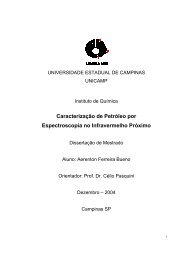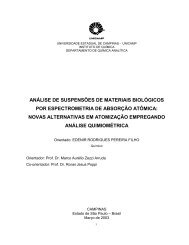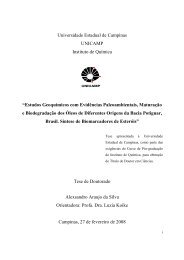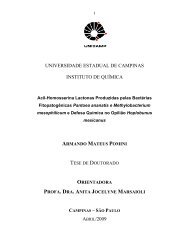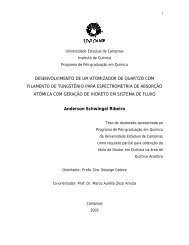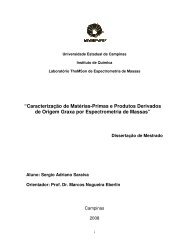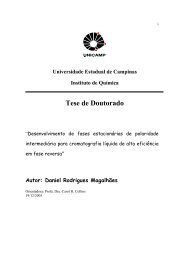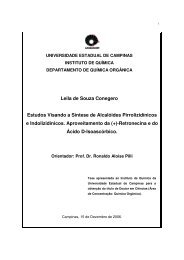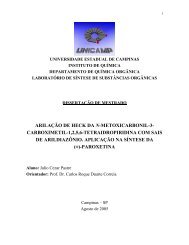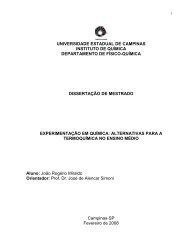tratamento redutivo de solo e água subterrânea contaminados com ...
tratamento redutivo de solo e água subterrânea contaminados com ...
tratamento redutivo de solo e água subterrânea contaminados com ...
Create successful ePaper yourself
Turn your PDF publications into a flip-book with our unique Google optimized e-Paper software.
Tese <strong>de</strong> DoutoradoCapítulo VIIINivas, B.R., Sabatini, D.A., Shiau, B.J., Harwell, J.H. (1996). Surfactant enhancedremediation of subsurface Cr contamination. Water Research, 30(3), 511-520.Newson, M. (Ed.) (1992). Managing the human impact on the natural environment:Patterns and Processes. London: Belhaven Press. Cap.2, pp.14-36.Nriagu, J.O. (1996). A History of Global Metal Pollution. Science, 272(5259), 223-224.Nriagu, J.O. (1988a). Historical perspective Em: Nriagu, J.O. & E. Nieboer, E. Chomiumin the natural and human environments. New York: Wiley. Vol. 20, cap.1, pp. 1-20.Nriagu, J.O. (1988b). Production and uses of chromium. Em: Nriagu, J.O. & E. Nieboer,E. Chomium in the natural and human environments. New York: Wiley. Vol. 20,cap.3. pp. 81-104.Nyer, E.K. (2001). Limitations of pump and treat remediation methods. Em: Nyer, E.K. Insitu treatment tecnology. CRC Press: Boca Raton. Cap.1. pp 1-40.Palmer, C.D., & Puls, R.W. (1994). Natural attenuation of hexavalent chromium ingroundwater and soils. Ground Water, U.S.EPA/540/S-94/505.Palmer, C.D. & Wittbrodt, P.R. (1991). Processes affecting the remediation of chromiumcontaminatedsites. Environmental Health Perspectives, 92(1), 25-40.Paudyn, A.M., Smith, R.G (1991). Microwave <strong>de</strong><strong>com</strong>posítion of dusts, ashes, andsediments for the <strong>de</strong>termination of elements by ICP-AES. Canadian Journal ofApplied Spectroscopy, 37(4), 94-99.Pettine, M., D´Óttone, L., Campanella, L., Millero, F.J., Passino, R. (1998). Thereduction of chromium(VI) by iron(II) in aqueous solutions. Geochimica etCosmochimica Acta, 62(9), 1509-1519.Pettine, M., Millero, F.J., Passino, R. (1994). Reduction of chromium (VI) with hydrogensulfi<strong>de</strong> in NaCl media. Marine Chemistry, 46(4), 335-344.Phenrat, T., Saleh, N., Sirk, K., Tilton, R.D., Lowry, G.Y. (2007). Aggregation andsedimentation of aqueous nanoscale zerovalent iron dispersions. EnvironmentalScience & Technology, 41(1), 284-290.Pon<strong>de</strong>r, S.M., Darab, J.G., Mallouk, T.E. (2000). Remediation of Cr(VI) e Pb(II) aqueoussolutions using supported, nanoscale zero-valent iron. Environmental Science &Technology, 34(23), 2564-2569.Powell, R.M., Puls, R.W., Hightower, S.K., Sabatini, D.A. (1995). Coupled iron corrosionand chromate reduction: mechanisms for subsurface remediation. EnvironmentalScience & Technology, 29(8), 1913-1922.Puls, R.W., Paul, C.J., Powell, R.M. (1999). The application of in situ permeable reactive(zero-valent iron) barrier technology for the remediation of chromate-contaminatedgroundwater: a field test. Applied Geochemistry, 14(8), 989-1000.Rai, D., Eary, L.E., Zacara, J.M. (1989). Environmental chemistry of chromium. TheScience of the Total Environment, 86(1-2), 15-23.Rai, D., Sass, B. M. Moore, D. A. (1987). Chromium(III) hydrolysis constants andsolubility of chromium(III) hydroxi<strong>de</strong>. Inorganic Chemistry, 26(3), 345-349.- 156 -



